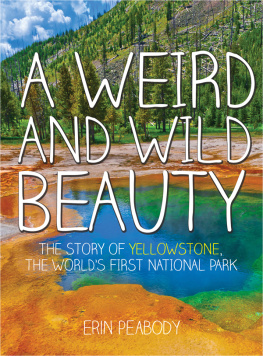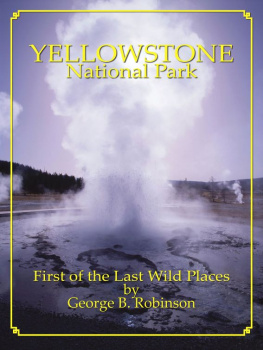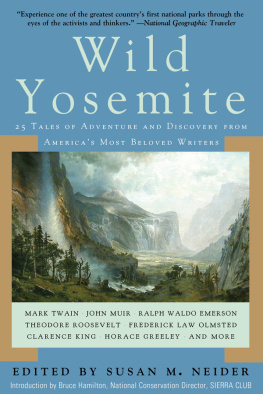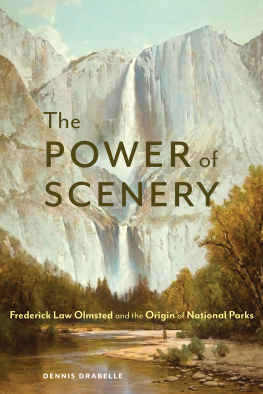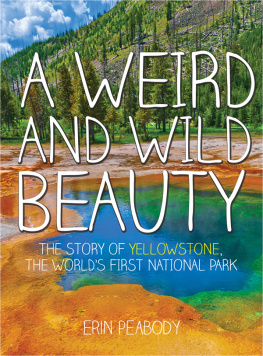Copyright 2016 by Erin Peabody
All rights reserved. No part of this book may be reproduced in any manner without the express written consent of the publisher, except in the case of brief excerpts in critical reviews or articles. All inquiries should be addressed to Sky Pony Press, 307 West 36th Street, 11th Floor, New York, NY 10018.
Sky Pony Press books may be purchased in bulk at special discounts for sales promotion, corporate gifts, fund-raising, or educational purposes. Special editions can also be created to specifications. For details, contact the Special Sales Department, Sky Pony Press, 307 West 36th Street, 11th Floor, New York, NY 10018 or .
Sky Pony is a registered trademark of Skyhorse Publishing, Inc., a Delaware corporation.
Visit our website at www.skyponypress.com.
10 9 8 7 6 5 4 3 2 1
Manufactured in China, October 2015
This product conforms to CPSIA 2008
Library of Congress Cataloging-in-Publication Data
Peabody, Erin.
A weird and wild beauty : the story of Yellowstone, the worlds first national park / Erin Peabody.
pages cm
Summary: The summer of 1871, a team of thirty-two men set out on the first scientific expedition across Yellowstone. Through uncharted territory, some of the days most renowned scientists and artists explored, sampled, sketched, and photographed the regions breathtaking wondersfrom its white-capped mountain vistas and thundering falls to its burping mud pots and cauldrons of molten magma. At the end of their adventure, the survey packed up their specimens and boarded trains headed east, determined to convince Congress that the country needed to preserve the land from commercial development. They returned with stories of wonder hardly short of fairy tales, to quote the New York Times. With the support of conservationists such as Ralph Waldo Emerson, Henry David Thoreau, Frederick Law Olmsted, and John Muir, the importance of a national park was secured. On March 1, 1872, Ulysses S. Grant signed the Yellowstone Park Bill into law. It set aside over two million acres of one-of-a-kind wilderness as a great national park for the benefit and enjoyment of people. This important and fascinating book will introduce young adults to the astonishing adventure that led to the best idea America ever had. Today over 130 countries have copied the Yellowstone model, and billions of acres of critical habitat and spectacular scenery are being preserved for all of us to enjoy. This book has a wonderful ecological and historical message for readers ages 12 and up. No book about Yellowstones founding has been written for this age group before, yet Yellowstone National Park is a major destination for many families, so many readers will likely have heard of Yellowstone or even have visited there. This is a great book for any school library or for history or science classrooms in middle and high school, where information can be used for research projectsProvided by publisher.
Audience: Grades 7 to 8.
Includes bibliographical references and index.
ISBN 978-1-63450-204-7
(print)ISBN 978-1-63450-935-0 (ebook)
1. Yellowstone National ParkHistoryJuvenile literature. 2. Yellowstone National ParkDiscovery and explorationJuvenile literature. 3. Yellowstone National ParkEnvironmental conditionsJuvenile literature. 4. National parks and reservesUnited StatesHistoryJuvenile literature. 5. Landscape protectionUnited StatesHistoryJuvenile literature. I. Title.
F722.P34 2016
978.752dc23
2015035831
Cover design by Sarah Brody
Cover photo credit Thinkstock
CONTENTS

The red dotted line represents the Hayden Expeditions route through Yellowstone in 1871. Map by Ryan Peabody.
PROLOGUE
DISBELIEF
While you see and wonder, you seem to need an additional sense... to comprehend and believe.
Nathaniel Langford, explorer in Yellowstone
NEW YORK CITY, WINTER 187071
J. G. Holland sat at his desk, staring wide-eyed at the pages spread before him. Holland was an editor at Scribners Monthly , a popular magazine and source of news for Americans in the mid- to late 1800s.
Holland had just received the most bizarre-sounding account. It spoke of a strange land where the ground gurgled and hissed. A land where scalding waters blew from craters and vats of steaming pink mud threatened to swallow a man whole. The place, according to the man whod recently traveled through the region, abounded with boiling springs, mud volcanoes, and huge mountains of sulphur.
Incredulous, Holland tried to absorb the dazzling imagery. The author, clearly spellbound by what he saw, gushed about brilliant turquoise pools and hot-water fountains. The mud volcano, the man wrote, erupted with the force of thundering cannons. Its boiling broth scalded trees hundreds of yards away.
This world of absurdities, the traveler informed Holland, was not some far-off land. It belonged to the United States.

J. G. Holland, editor at Scribners Monthly magazine, opened himself to criticism when he published a jaw-dropping account on the wonders of Yellowstone in 1871. The journalist died ten years later with the phrase to devote life to truth etched in Latin on his gravestone.

Artists woodcut of a mud volcano appearing in Scribners Monthly.
Impenetrable snow and ice, as well as fears about hostile Native tribes, had kept men from exploring this region, as had rumors about the areas infernal boilers that supposedly belched steam, reeked of death, and harbored sinister spirits.
Scribners similar to todays Time or Life magazineswas a common fixture in American households in the nineteenth century. Readers prized its lavish illustrations (as photographs were still a rare treat) and rushed to read its latest features on history, science, religion, and art. And by the 1860s, travel writing had become popular, especially stories about Americas exotic western frontier.

The first issue of the monthly periodical Scribners Monthly.
To most Easterners living and working in cramped, smoke-filled factory towns, the American Westwith its dramatic scenery, invigorating air, and populations of curious indigenous peopleseemed unusual, enticing, and bursting with possibility.

Images, like this painting by Albert Bierstadt, drew Americans westward.
Ever since the trailblazers Meriwether Lewis and William Clark shared the fascinating details of their daring journey in 1804 across the country to the Pacific Ocean and back, Americans had craved details about the little-known western half of their country.
Scribners readers tracked the progress of western adventurers such as John C. Fremont with great excitement. His gritty accounts of scaling mountains and surviving blazing desert heat appeared in the nations newspapers as well as the penny press, a tabloid-style paper that sold for a penny a piece and made news affordable for the working class.

